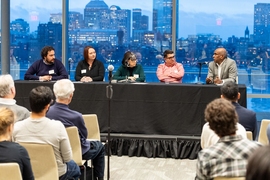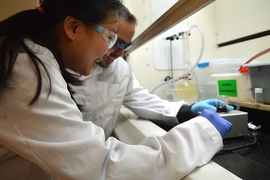During MIT's Independent Activities Period (IAP) this January, first-year students interested in civil and environmental engineering (CEE) participated in a four-week undergraduate research opportunities program known as the mini-UROP (1.097). The six-unit subject pairs first-year students with a CEE graduate student or postdoc mentor, providing them with an inside look at the interdisciplinary research being conducted in the department. Overall, eight labs in the department opened their doors to the 2024 cohort, who were eager to take advantage of the opportunity to collaborate with current students and build a community around their interests.
“The mini-UROP presents an opportunity for first-year students to experience the diverse climate and sustainability research happening in our department,” says CEE department head and JR East Professor Ali Jadbabaie. “Fostering hands-on experiences in a collaborative, supportive educational environment is central to our mission of preparing students with the skills needed to positively shape the future of our society, systems, and planet.”
The mini-UROP also benefits the graduate students and postdocs who take on the role of mentor. Mentor support is a key component to completing a successful mini-UROP project and requires graduate students and postdocs to hone their leadership and teaching skills.
“I’m always interested in mentoring undergraduate students and to have someone help me with my project,” says postdoc and mentor Yue Hu. “Participating in this project made me excited that my research attracted undergraduates’ interest.”
Guiding students through interactive workshops
Preparation for this year’s mini-UROP began at the end of November, when participants attended the Lightning Lectures, an event that served as an opportunity for the mentors to give lightning-fast pitches on their research projects. First-year students then ranked the projects that they were interested in working on and were matched according to their preferences.
The interdisciplinary nature of the department’s research offered participants a wide range of projects to work on, from redefining autonomous vehicle deployment to mitigating the effects of drought on crops. Once each of the 11 participants were matched to a project, the mini-UROP Kick-off Lunch brought students and mentors together and ensured each group had an open line of communication.
Throughout the duration of the mini-UROP, participants attended three workshops led by Jared Berezin, the manager of the Civil and Environmental Engineering Communication Lab (CEE Comm Lab). The communication lab is a free resource to undergraduates, graduates, and postdocs in the CEE community, providing one-on-one coaching and interactive workshops. Held on Fridays during IAP, the workshops helped students contextualize their research and ensure they were able to explain the scientific concept of their work during presentations.
“Students were fortunate to have research mentors in the lab, and my goal was to provide communication mentorship outside of the lab,” says Berezin. “Our weekly workshops focused on scientific communication strategies, but perhaps more importantly I’d prompt them to talk about their projects, ask questions, and brainstorm together. They really embraced the opportunity to foster a supportive peer community, which I think is a core part of the CEE experience.”
A significant challenge students face while completing the program is condensing their research down to a clear and concise two-minute presentation. To assist with this task, the third workshop featured a presentation by CEE Comm Lab fellow Matthew Goss, providing students with a preview of how their own presentations may take shape. Students also had the option to meet with Comm Lab fellows to practice presenting and get feedback.
“The final talks were impressive, and I was proud of the students for approaching both their research and communication challenges with such curiosity and thoughtfulness,” Berezin remarks.
Reinforcing research interests
Iraira Rivera Rojas, a first-year student interested in materials science and environmental engineering, worked with Yue Hu, a postdoc in Associate Professor Benedetto Marelli’s lab. Their project used biodegradable polymers, specifically silk fibroin, to make particles that can be used to encapsulate agrochemicals, lessening their negative impact on the environment. Regenerated from silk cocoons, the silk fibroins are used as a building block to revolutionize the agriculture and food industry.
“When I saw the project description, it was a mix of both of my interests,” Rojas says. “I thought it would be a good way to try out both fields.” While she is still deciding which course she will major in, she says that participating in the mini-UROP confirmed her interest in the field.
Working with mentor Jie Yun, a graduate student in Associate Professor David Des Marais’s lab, Sheila Nguyen and Ved Ganesh used biodiversity to increase crop drought resistance. Nguyen and Ganesh studied barley, oat, wheat, and Brachypodium, and compared how these plants grow under conditions of drought stress. Currently, a separate model must be trained for each plant species and type of cell. The project aimed to develop a machine learning model that can generalize to different species of plants and cell types.
Vinn Nguyen and Diego Del Rio worked with mentor Cameron Hickert, a graduate student in Assistant Professor Cathy Wu’s Lab. Their project focused on making autonomous vehicles safer and more reliable, specifically in areas transitioning on and off highways. As self-driving cars gain popularity, reports of crashes and similar incidents demonstrate deficiencies in the current system. Nguyen and Del Rio sourced satellite imagery and applied computer vision techniques to investigate the safeness of these areas. The goal of their project was to design an infrastructure-supported approach to autonomous vehicles that allows passenger to comfortably work, play, and connect with partial autonomy.
Jordyn Goldson worked in the Terrer Lab with her mentor Kathryn Wheeler, a graduate student in Assistant Professor Cesar Terrer’s lab, on a project focused on plant senescence. As warmer temperatures lengthen plants’ growing period each year, total annual photosynthesis increases along with the amount of carbon plants remove from the atmosphere. Her project investigated if model performance differs between predicting visually assessed timing versus remotely sensed timing. The findings can help advance knowledge of the mechanisms behind forest canopy color change and the ability of forests to capture more carbon by growing longer, mitigating climate change.
Based on the success of her mini-UROP project, Mairin O’Shaughnessy, who worked in Professor Heidi Nepf’s lab with graduate student Ernie Lee, will be continuing her research on “Computer Vision for Plant Density Analysis” in the spring.
“When Heidi and Ernie, the grad student advisor for the project, proposed continuing the project in spring, I was interested in continuing to learn more and explore vision processing for counting real plants,” O’Shaughnessy says.
Jennifer Espinoza, another student who worked in the Nepf Lab, plans to continue her research with graduate student James Brice on “Characterizing Flow Conditions.”
“One of the main things I loved most about working in the lab was the passion that my mentor, James, portrayed for his work, as well as his willingness to teach me anything without complaint,” says Espinoza. “Most of all, though, I became extremely passionate about my work because it has the potential to make an impact in not only society but the natural environment. The significance of my work and the welcoming working environment have prompted me to continue researching at Nepf Lab in the spring.”










